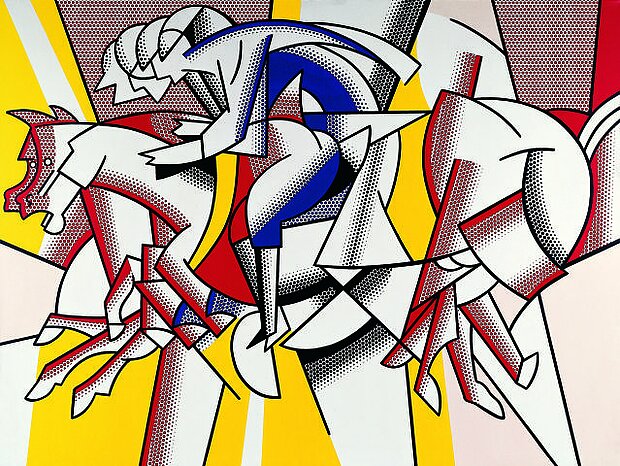mumok is closed until June 6, 2024 for renovation work.
All information about the renovation project and our alternative program can be found here.

Detail
Lichtenstein, Roy
The Red Horseman,
1974

© mumok
| Object category | Allgemein |
|---|---|
| Object description | Oil, magna on canvas |
| Dimensions |
Rahmenmaß:
height: 216,5 cm,
width: 289,1 cm,
depth: 8 cm
Objektmaß:
height: 213,5 cm,
width: 284,5 cm
|
| Inventory number | L 138/0 |
| Year of acquisition | 1978 |
| Creditline | mumok - Museum moderner Kunst Stiftung Ludwig Wien, Leihgabe der Sammlung Ludwig, Aachen |
| Rights reference | Bildrecht, Wien |
| Further information | GND |
In "The Red Horseman" Roy Lichtenstein paraphrases the painting of the same name by futurist Carlo Carrà created in 1913, a homage to motion and speed, itself only known as a reproduction. Lichtenstein quotes the famous original not as a famous object of high culture but as a randomly accessible part of a mass culture that no longer distinguishes between popular and high culture. Lichtenstein’s polemic against the utopia of the futurist painting finds expression in the commercial imagery of the benday dots points to which he subjects the original image. In the process of transferring to unmodulated colors, dotted shadings and fixed contours, Lichtenstein freezes the motion of the original and cancels out the dynamic effect of the painting. “Formally speaking, of course, I copy, but in reality a give a different portrayal of what I copy. The original is given a totally different texture. Instead of thick and thin brushstrokes there are dots, flat colors and rigid outlines. This may seem like anti-art, but that’s not the way I see it”. The prerequisite for levelling out trivial and high culture are the reproduction techniques that facilitate mass distribution of unique originals. As early as 1936 philosopher Walter Benjamin prophesies the loss of aura, works of art would suffer through reproduction, the end of uniqueness and originality, which elevates them above the commonplace. Lichtenstein’s oeuvre seems like a revision of this thesis, as Pop Art critic Lawrence Alloway points out: “Roy turns citation into a form of originality all his own.”
© mumok – museum moderner kunst stiftung ludwig wien